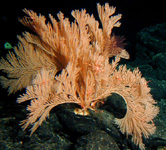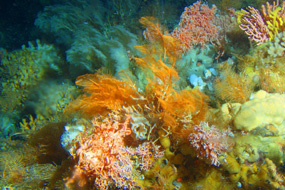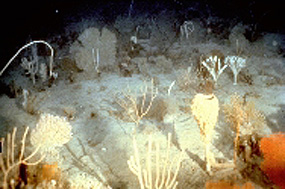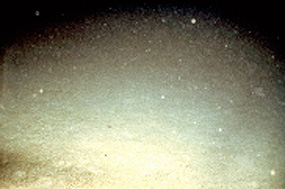 |
 |
 |
 |
 |
 |
 |
 |
 |
 |
|
|
  |

 |

|
Home > Environmental issues > Article > |
|

Scientists call for deepsea coral protection: Ban on bottom trawling needed16 February 2004In an unprecedented action, 1,136 experts in the marine sciences and conservation biology from 69 countries, released a statement at the annual meeting of the American Association for the Advancement of Science, calling for governments and the United Nations to protect deepsea coral and sponge ecosystems. The scientists are calling for a moratorium on destructive bottom trawl fishing. The statement was also released at the United Nations Convention on Biological Diversity. The scientists state "... until quite recently, few people - even marine scientists - knew that the majority of coral species live in colder, darker depths, or that some of these form coral reefs and forests similar to those of shallow waters in appearance, species richness and importance to fisheries ..."
|
|
 |
"Because seamounts are essentially undersea islands, many seamount species are endemics that occur nowhere else - and are therefore exceptionally vulnerable to extinction." |
|
|
|
"Moreover, marine scientists have observed large numbers of commercially important but increasingly uncommon groupers and redfish among the sheltering structures of deepsea coral reefs ..." Many gorgonian coral forests and reefs of stony corals have been recent discoveries in cold and deep ocean waters around the world. Some corals form dense thickets, and others are in the form of "trees" as high as 10 metres. There are more coral species in cold and deepsea waters than tropical waters. Until quite recently, scientists were not aware that coral forests and sponge reefs are widespread in certain cold and deep ocean habitats. Deep ocean forests are the habitat of thousands of species, many of them unknown to science. It is a race in time for protection, as many coral and sponge ecosystems will be destroyed by commercial fishing before science can even find or identify them. Bottom trawling began more than two decades ago with a complete indifference to the habitat of the fish being caught. Deepsea fishing vessels drag massive nets that are weighted down, and are assisted across the seafloor by heavy rollers, picking up everything in their path. In the course of catching commercial seafood such as shrimp and orange roughy, corals, sponges and invertebrates are raked up or smashed, leaving the seabed barren like a ploughed field. |
|
Deepsea bottom trawling is the ocean equivalent of clearcutting terrestrial forests. It has an immediate double impact - depleting the fish population, and at the same time destroying their habitat and preventing sustainable recovery. |
|
|
Approximately 98 percent of ocean species live right above or in the seafloor. Corals and sponges on the rocky bottoms of continental slopes and seamounts, provide habitat for countless marine wildlife. The scientists' statement says "Lophelia coral reefs in cold waters of the Northeast Atlantic have over 1,300 species of invertebrates, and over 850 species of macro- and megafauna were recently found on seamounts in the Tasman and Coral Seas, as many as in a shallow-water coral reef. Deepsea corals are the oldest known ocean animals. Some corals contain irreplaceable archives of global climate change. It is possible, through a greater public awareness, to recognize and appreciate the forests of the deep ocean, in the same manner as forests on land. The fishing industry is aware of the extent of coral from the amount that is caught in nets, and governments are aware from surveys. Unfortunately they have both concentrated on short-term fishing industry economic growth, rather than the longterm conservation of the biodiversity of a sustainable fishery. When coastal fisheries became depleted, bigger fishing vessels with heavier gear and sophisticated instruments moved into the deepseas, reaching as deep as two kilometres. Now as many ocean fisheries are already becoming over-fished, vessels are being equipped for the most remote seas on Earth, such as the Ross Sea in Antarctica. |
|

North Pacific Ocean deepsea coral forest in the Aleutian Islands, west of AlaskaPhoto Alberto Lindner, NOAA Fisheries
|
|
|||
 |
|||
 |
|||
The flattening of deepwater coral is New Zealand's modern-day version of environmental destruction, comparable with the loss of the kauri forests in the 19th century. There is a striking similarity of the two events - natural resources destroyed by exploitation for profit without consideration of conservation; and long-living, slow growing species destroyed without knowledge of their origin, age or growth characteristics. Cold water coral usually grows only 1.5mm a year, and one species has been dated to have lived for 1800 years. Coral forests will take thousands of years to recover from trawler damage, just as giant kauri forest will from logging. In Deep New Zealand, marine biologist Peter Batson from Otago University wrote "Anecdotal accounts of fishing virgin seamounts tell of trawl nets filled with coral trees, and of repeated hauls over the same seamount yielding progressively fewer and fewer coral fragments ... though we may never know, it is quite possible that undiscovered species have become extinct in the last two decades through deepwater fishing, without our ever encountering them." |
 See the full "Scientists' Statement on
Protecting the World's Deepsea Coral and Sponge Ecosystems"
See the full "Scientists' Statement on
Protecting the World's Deepsea Coral and Sponge Ecosystems" Primnoid coral, Hawaii
Primnoid coral, Hawaii View larger image
View larger image